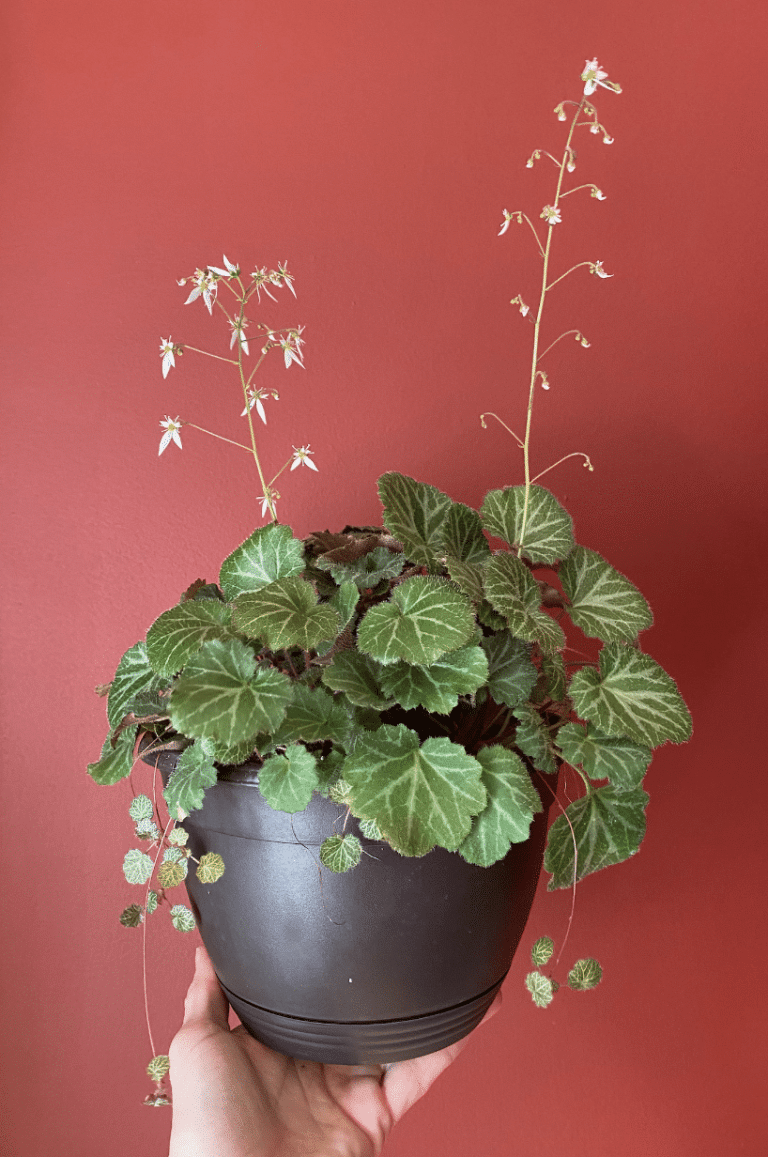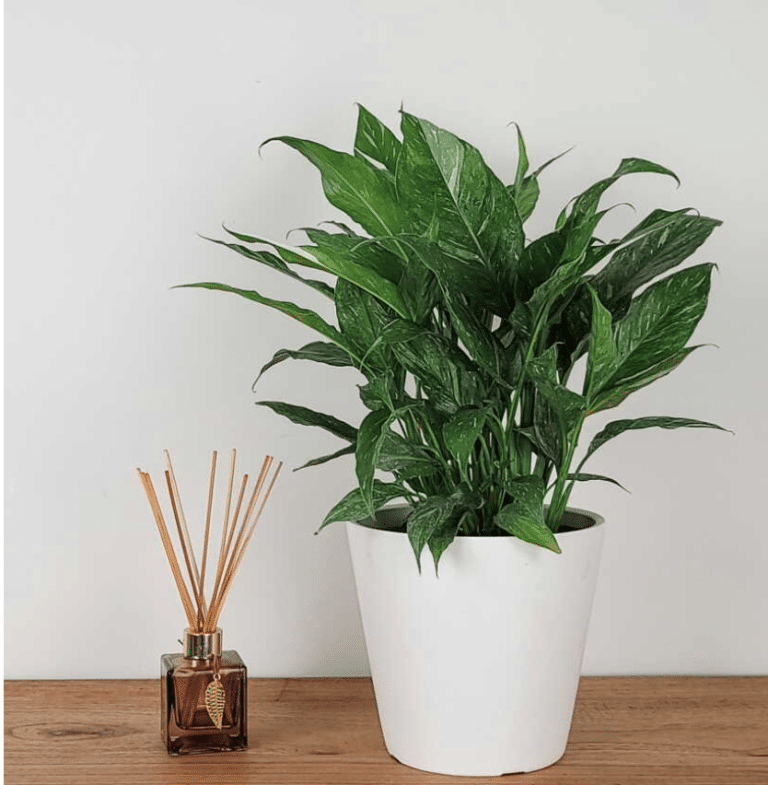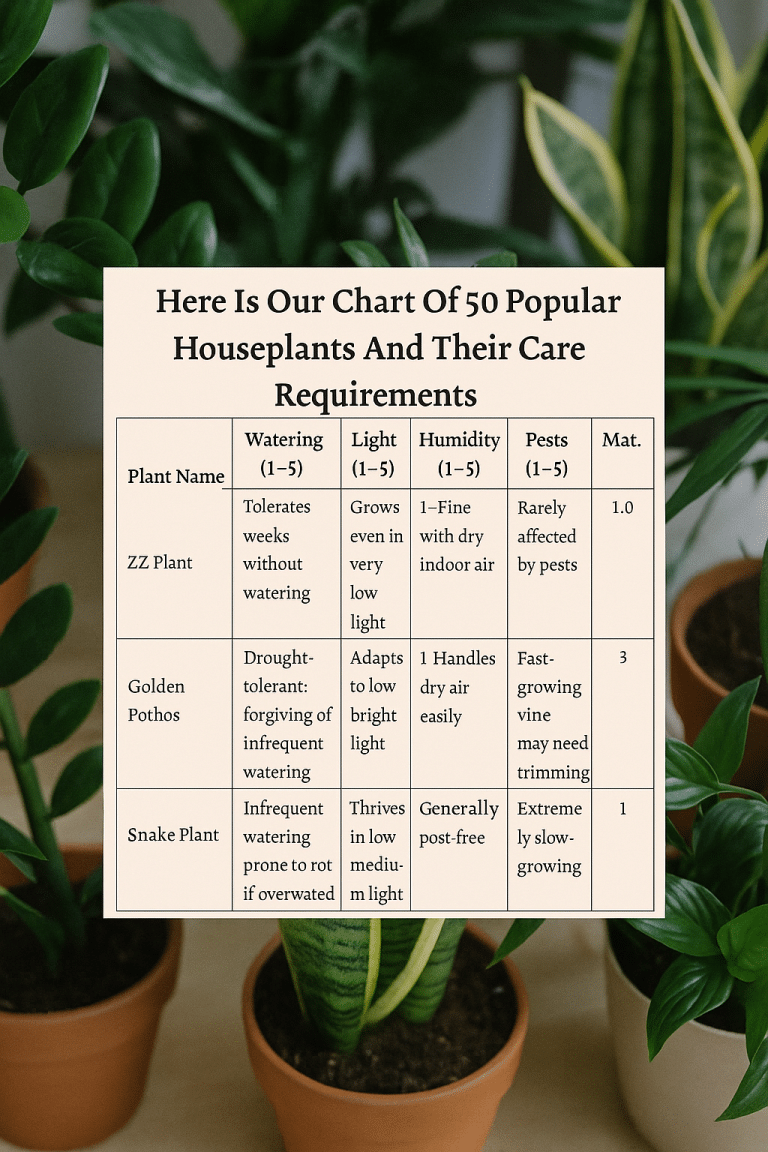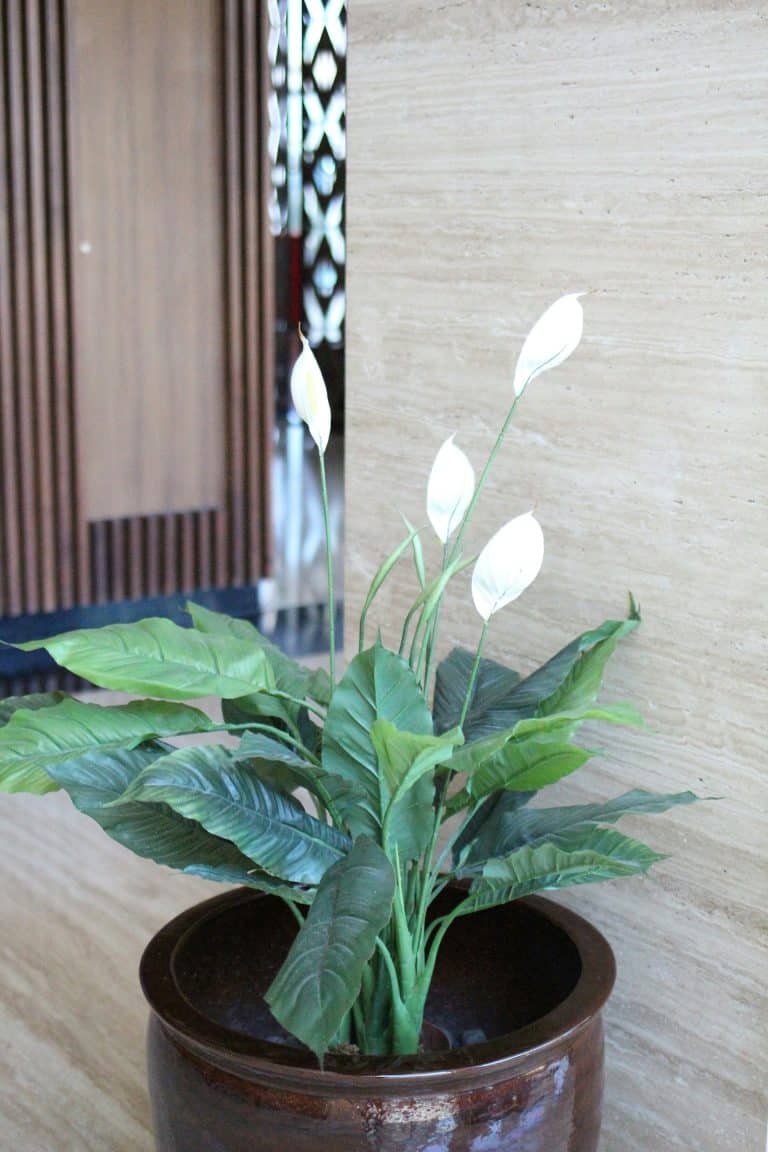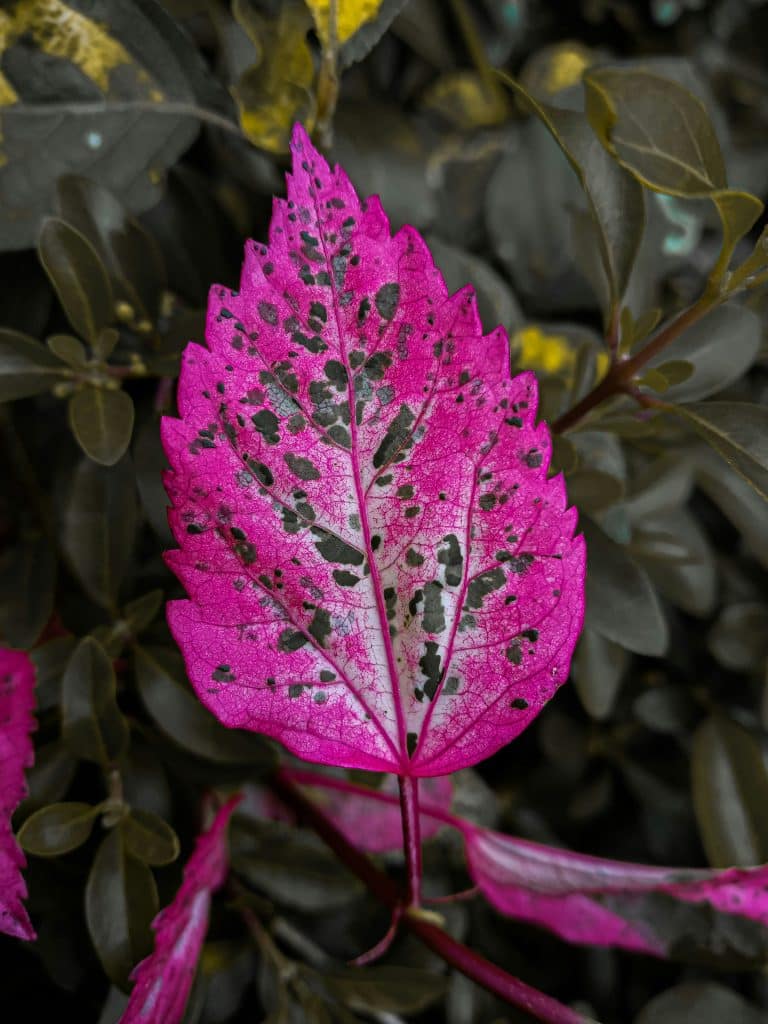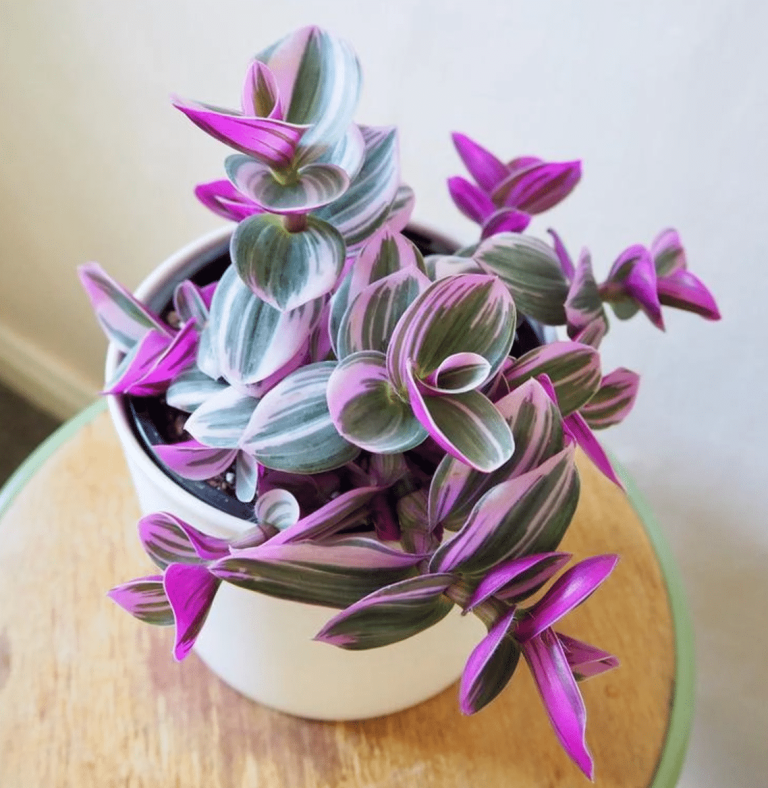Cat Toxicity Chart: 50 Houseplants, Their Toxins, Symptoms & What to Do
Is your houseplant toxic to cats? This trusted guide lists 50 common toxic houseplants with details on the part that’s dangerous, the compound involved, symptoms to watch for, and what to do if your cat eats it.
We have two cats. We love them. And we also love houseplants—which makes things tricky because there aren’t very many houseplants that are safe for cats. A couple years ago, one of our cats somehow got into the top floor and munched an entire fiddle leaf fig leaf. We panicked. Googled everything. Called our vet in that same anxiety.
He was okay, thank goodness. But it shook us up. We haveall the toxic plants to the top floor—a no-cat zone—and started tracking which plants were safe, and which weren’t. We’ve consulted our veterinarian, read everything from ASPCA to university vet school sites, and built a chart we now use constantly!
This isn’t just a list that says “toxic.” It’s a detailed guide that tells you what part is dangerous, what compound is in it, what happens, and what to do if your cat eats it. We hope this helps you keep your plants—and your pets—safe.
Understanding Toxicity in Houseplants
Not all plant poisonings look the same. Some cause vomiting. Some cause liver damage. Others can shut down kidneys altogether.
Most toxic houseplants fall into a few categories of compounds: calcium oxalates, saponins, alkaloids, or glycosides.
Calcium oxalates can make a cat drool or paw at their mouth. Glycosides—like those in oleander—can affect the heart. Even a “mild” toxin can still make your cat miserable.
And severity depends on how much they eat, what part of the plant it was, and how fast you act. Here in this chart we have listed all the information we find useful as a handy guide — because lets face it, we all forget which is one is toxic and which one isn’t when we see some new plant that we want to bring home!
Here is our chart of 50 popular houseplants with its toxicity information, and what to do if you pet accidently swallows it
Plant Name | Toxic Part | Toxic Compound | Severity | Symptoms | What to do if ingensted |
|---|---|---|---|---|---|
Golden Pothos (Devil’s Ivy) | All parts (leaves, stems) | Insoluble calcium oxalate crystals | Moderate | Oral irritation (burning of mouth, tongue, lips), drooling, vomiting, difficulty swallowing | Remove any plant material, rinse mouth with water. Contact a veterinarian or poison control; seek vet care if swelling or breathing trouble occurs. |
Snake Plant (Mother-in-Law’s Tongue) | All parts (especially leaves) | Saponins | Mild | Nausea, vomiting, diarrhea (gastrointestinal upset) | Offer water and monitor. Prevent further ingestion. Contact a vet if vomiting is severe or persistent. |
Aloe Vera | Leaves (particularly the gel/latex in leaf) | Anthraquinone glycosides (e.g. aloin) | Moderate | Vomiting, diarrhea (often red-tinged due to plant pigments), lethargy | Wipe away any plant gel from the cat’s mouth. Ensure the cat stays hydrated; contact a vet if diarrhea or vomiting persists. |
Peace Lily (Mauna Loa) | All parts | Insoluble calcium oxalate crystals | Moderate | Intense burning of mouth and tongue, drooling, vomiting, difficulty swallowing | Rinse the mouth with water to dilute crystals. Contact a vet or poison control for guidance; monitor for throat swelling. |
Moth Orchid (Phalaenopsis) | None – Non-toxic | None | Non-toxic | Safe for cats; no symptoms expected | No action needed unless the cat shows unusual behavior (unlikely). |
None – Non-toxic | None | Non-toxic | Safe for cats; no symptoms expected (large amounts may cause mild nausea) | No action needed unless the cat shows digestive upset (rare and mild). | |
Jade Plant (Crassula) | All parts (fleshy leaves, stems) | Unknown irritant (toxic principle unknown) | Moderate | Vomiting, depression (lethargy), incoordination; rarely, slow heart rate | Remove plant material from the cat’s mouth. Contact a veterinarian for advice; monitor for worsening of symptoms or lethargy. |
African Violet | None – Non-toxic | None | Non-toxic | Safe for cats; no symptoms expected | No action needed unless the cat shows unusual behavior. |
Rubber Plant (Ficus elastica) | All parts (sap in leaves/stems) | Proteolytic enzymes (ficin) and psoralen (ficusin) | Mild | Irritation of mouth, drooling, vomiting, diarrhea; contact with sap may cause skin redness | Rinse out mouth and wipe off any sap from fur/skin. Offer water and monitor; contact a vet if vomiting or skin irritation continues. |
Money Tree (Pachira) | None – Non-toxic | None | Non-toxic | Safe for cats; no symptoms expected (ingestion may cause minor stomach upset in rare cases) | No action needed unless the cat shows prolonged vomiting or other unusual behavior. |
Lucky Bamboo (Dracaena sanderiana) | All parts | Steroidal saponins (unknown specific types) | Moderate | Drooling, vomiting, abdominal pain, diarrhea, weakness; cats may show dilated pupils | Remove any chewed plant pieces. Offer water and contact a vet or poison helpline for guidance; monitor for dehydration or persistent vomiting. |
English Ivy | Leaves (more toxic than berries) | Triterpenoid saponins (hederagenin) | Moderate | Vomiting, abdominal pain, drooling, diarrhea | Prevent further ingestion. Rinse out mouth with water; contact a vet if symptoms are significant or the cat ate a large amount. |
ZZ Plant (Zamioculcas) | All parts | Insoluble calcium oxalate crystals | Mild | Irritation of mouth, drooling, possible vomiting, reluctance to eat | Rinse the cat’s mouth with water to soothe irritation. Monitor for improvement; consult a vet if vomiting continues or the cat refuses food. |
Boston Fern | None – Non-toxic | None | Non-toxic | Safe for cats; no symptoms expected | No action needed aside from routine observation. |
Areca Palm | None – Non-toxic | None | Non-toxic | Safe for cats; no symptoms expected | No action needed. |
Fiddle Leaf Fig (Ficus lyrata) | All parts (sap in leaves, stems) | Insoluble calcium oxalate crystals (in irritant sap) | Mild | Oral irritation (mouth/tongue pain), drooling, vomiting; possible skin irritation from sap | Wipe sap from the mouth or skin and rinse mouth with water. Monitor for discomfort; contact a vet if vomiting persists or mouth swelling occurs. |
Parlor Palm (Chamaedorea) | None – Non-toxic | None | Non-toxic | Safe for cats; no symptoms expected | No action needed. |
Bromeliads (e.g., Guzmania) | None – Non-toxic | None | Non-toxic | Safe for cats; no symptoms expected (occasionally mild stomach upset if leaves are chewed) | No action needed unless rare vomiting/diarrhea occurs (then consult a vet if it doesn’t resolve). |
Dragon Tree (Dracaena marginata) | All parts (leaves, bark) | Saponins (steroidal glycosides) | Moderate | Drooling, vomiting (sometimes with blood), loss of appetite, depression; cats may develop dilated pupils | Remove any plant fragments from the mouth. Offer a small amount of water or milk to dilute stomach contents. Contact a vet for guidance and monitor closely. |
Croton (Codiaeum) | All parts (leaves, sap) | Irritant oils/resins in sap (toxins not fully characterized) | Moderate | Mouth irritation (sometimes drooling), vomiting, diarrhea, loss of appetite; possible skin irritation from sap | Rinse out the mouth with water. Wash sap off fur/skin with mild soap and water (wear gloves). Contact a veterinarian if significant vomiting or irritation occurs. |
Chinese Evergreen (Aglaonema) | All parts | Insoluble calcium oxalate crystals | Moderate | Oral pain, drooling, swelling of tongue/lips, difficulty swallowing, vomiting | Rinse mouth with water to relieve irritation. Contact a vet, especially if swelling causes breathing issues or the cat cannot eat/drink. |
Ponytail Palm | None – Non-toxic | None | Non-toxic | Safe for cats; no symptoms expected | No action needed. (The plant is harmless, though eating a lot of any plant may cause mild upset.) |
Oyster Plant (Tradescantia spathacea) | All parts (leaves contain sap) | Irritant sap (contains oxalates and other irritants) | Mild | Mild gastrointestinal upset (drooling, vomiting) and occasionally skin irritation on contact | Wipe out the mouth and paws (to remove sap). Monitor for persistent vomiting or rash; consult a vet if symptoms worsen or do not resolve. |
Kalanchoe (Flaming Katy) | All parts (flowers have highest concentration) | Bufadienolide cardiac glycosides | High | Vomiting, diarrhea, drooling; in large ingestions, abnormal heart rhythm, tremors, seizures (rare) | Emergency: Contact a veterinarian or Pet Poison Helpline immediately. Do not induce vomiting unless directed. Prompt treatment is crucial if a large amount was consumed. |
Jasmine (Jasminum spp.) | None – Non-toxic | None | Non-toxic | Safe for cats; no symptoms expected | No action needed (true jasmine plants are not poisonous to cats). |
Heartleaf Philodendron | All parts | Insoluble calcium oxalate crystals | Moderate | Intense mouth irritation, drooling, pawing at mouth, vomiting, difficulty swallowing | Rinse mouth with clean water. Contact a vet for guidance; offer something cool like water or yogurt to soothe mouth, and watch for improvement. |
Silver Leaf Philodendron (e.g., Satin Pothos) | All parts | Insoluble calcium oxalate crystals | Moderate | Oral irritation (burning sensation), drooling, vomiting, lack of appetite due to pain | Rinse the cat’s mouth with water. Keep the cat from eating more and call a veterinarian if significant symptoms occur or persist. |
Polka Dot Begonia (Begonia maculata) | All parts (especially roots/tubers) | Insoluble oxalate crystals (concentrated in tubers) | Mild | Drooling, vomiting, difficulty eating (due to mouth irritation) | Offer the cat water or milk to help rinse the mouth. Monitor for continued vomiting; if it lasts more than a few episodes, consult a veterinarian. |
Black Velvet Alocasia (Alocasia reginula) | All parts | Insoluble calcium oxalate crystals | Moderate | Severe oral irritation, intense burning of mouth and throat, drooling, vomiting, difficulty swallowing | Rinse out the mouth immediately with water. Contact a vet promptly due to the risk of throat swelling; keep the cat calm and breathing freely. |
Bird’s Nest Anthurium | All parts | Insoluble calcium oxalate crystals | Moderate | Oral pain and swelling, drooling, vomiting, difficulty swallowing (similar to Dieffenbachia effects) | Rinse the mouth thoroughly with water. Seek veterinary care if the cat shows significant swelling or pain, or if eating/drinking is difficult. |
Ficus Audrey (Ficus benghalensis) | All parts (sap in leaves/stems) | Proteolytic enzyme (ficin) and psoralen (ficusin) | Mild | Mild oral irritation, drooling, vomiting; potential dermatitis if sap contacts skin | Wipe away any sap and rinse the mouth with water. Monitor for mild vomiting or drooling; call a vet if symptoms do not resolve or the cat seems very uncomfortable. |
Homalomena ‘Selby’ | All parts | Insoluble calcium oxalate crystals | Moderate | Mouth irritation (pain, drooling), vomiting, reluctance to eat; possibly diarrhea and lethargy if ingested in quantity | Rinse the cat’s mouth with water to ease irritation. Prevent further chewing. If vomiting or pain continues, consult a veterinarian. |
Prayer Plant (Maranta) | None – Non-toxic | None | Non-toxic | Safe for cats; no symptoms expected | No action needed. (Ingestion of this plant is not harmful to cats.) |
Gardenia (Cape Jasmine) | All parts (flowers, leaves) | Genioposide and gardenoside (iridoid glycosides) | Mild | Mild vomiting and/or diarrhea; in some cases, hives or skin rash | Generally mild: offer water and monitor. If vomiting or rash persists or the cat seems uncomfortable, contact a veterinarian for advice. |
Sweetheart Hoya (Hoya kerrii) | None – Non-toxic | None | Non-toxic | Safe for cats; no symptoms expected (ingesting large quantities may cause minor upset) | No action needed apart from monitoring for any unusual behavior (unlikely). |
Monstera adansonii (Swiss Cheese Vine) | All parts | Insoluble calcium oxalate crystals | Moderate | Oral burning and irritation, drooling, crying out in pain, vomiting, difficulty swallowing | Rinse mouth with water to reduce irritation. Contact a vet if the cat continues to vomit or shows swelling of the mouth/throat. |
String of Pearls (Senecio) | All parts (leaves, sap) | Unknown (suspected pyrrolizidine alkaloids) | Moderate | Vomiting, diarrhea, drooling, lethargy; Note: sap can irritate skin and eyes | Remove any plant pieces from the cat’s mouth. Rinse mouth and paws with water. Contact a veterinarian, especially if a large amount was eaten or if the cat becomes lethargic. |
Cast Iron Plant (Aspidistra) | None – Non-toxic | None | Non-toxic | Safe for cats; no symptoms expected | No action needed (this plant is cat-friendly). |
Assorted Succulents | Varies by species (Unknown) | Varies by species (Unknown) | Unknown | Unknown/Varies: Some succulents are non-toxic (no symptoms), others cause mild GI upset (vomiting, diarrhea) | Identify the specific succulent species ingested. If unsure, err on the side of caution: monitor the cat and contact a vet or poison control if any unusual symptoms occur. |
Flamingo Flower (Anthurium) | All parts | Insoluble calcium oxalate crystals | Moderate | Burning of mouth and throat, drooling, vomiting, difficulty swallowing (similar to Peace Lily) | Rinse out the mouth with water. Contact a vet for guidance and observe for any breathing difficulty or inability to eat. |
Olive Tree (Olea europaea) | None – Non-toxic | None | Non-toxic | Safe for cats; no poisoning symptoms (olive leaves/fruit are not toxic to cats) | No action needed. (Eating a few leaves or fruit may cause only minor GI upset, if any.) |
Bird of Paradise (Strelitzia reginae) | Fruit, seeds (flowers and leaves less so) | GI irritants (tannins, etc. in seed/fruit) | Mild | Mild nausea, vomiting, and drowsiness; symptoms primarily if seeds or fruit are ingested | Remove any remaining fruit/seed material from the cat’s mouth. Offer water and monitor; if lethargy or vomiting persists beyond a couple of hours, consult a veterinarian. |
Corn Plant (Dracaena fragrans) | All parts (especially leaves) | Saponins (steroidal) | Moderate | Vomiting (occasionally with blood), loss of appetite, drooling, depression; cats may have dilated pupils | Wipe out the mouth to remove plant residue. Encourage hydration. Seek veterinary advice, as medication may be needed to alleviate symptoms; monitor closely until the cat recovers. |
Philodendron ‘Birkin’ | All parts | Insoluble calcium oxalate crystals | Moderate | Oral irritation (pain, swelling), drooling, vomiting, refusal to eat due to discomfort | Rinse the mouth with water. Keep the cat calm and keep food/water available; if significant symptoms continue, get veterinary care for pain relief and anti-nausea treatment. |
Tradescantia zebrina (Wandering Jew) | All parts (sap in stems/leaves) | Irritant compounds in sap (oxalates and others) | Mild | Mild vomiting, drooling, and/or diarrhea; skin redness or itch if prolonged contact with sap | Clean the cat’s mouth and any sap on fur with water. Monitor for minor GI upset or skin irritation; usually it resolves. Consult a vet if vomiting is frequent or the skin reaction is severe. |
None – Non-toxic | None | Non-toxic | Safe for cats; no symptoms expected (ingestion of Hoya plants is generally harmless) | No action needed, other than perhaps cleaning up any plant mess. | |
Monstera deliciosa (Split-Leaf Philodendron) | All parts | Insoluble calcium oxalate crystals | Moderate | Intense mouth irritation, drooling, vomiting, difficulty swallowing (similar to other arums) | Rinse the cat’s mouth with water to remove irritants. Contact a vet if the cat is very distressed or cannot eat/drink after a short time. |
Dracaena (all species) | All parts (leaves, stalks) | Steroidal saponins | Mild | Vomiting, drooling, anorexia, depression; large ingestions can cause incoordination and weakness (cats may also have wide pupils) | Remove any plant material, offer water. Generally self-limiting, but call a vet if a large amount was consumed or if the cat is very weak or won’t eat. |
Dumb Cane (Dieffenbachia) | All parts (stems and leaves) | Insoluble calcium oxalate crystals (raphides) and proteolytic enzymes | Moderate | Immediate burning/irritation of mouth and throat, excessive drooling, pawing at mouth, vomiting; potential swelling of tongue and difficulty breathing if severe | Urgent Care: Rinse mouth thoroughly with water (use a wet cloth to wipe the mouth). Seek veterinary care if any swelling is observed or if the cat is in significant distress, as swelling can obstruct breathing. |
Calathea (Peacock/Prayer Plant) | None – Non-toxic | None | Non-toxic | Safe for cats; no symptoms expected | No action needed. (Calathea species are pet-friendly houseplants.) |
Most Dangerous Offenders
Some plants are dangerous. Others are deadly. These are the top five we avoid having anywhere cats can reach:
Sago Palm – Even a small amount can cause fatal liver failure. This one’s non-negotiable. Never in reach.
Lilies – Especially toxic to cats. Even pollen or water from the vase can cause kidney failure.
Oleander – Contains cardiac glycosides. Can cause irregular heartbeat and death. Definitely not a houseplant for a cat household.
Dieffenbachia – Looks harmless, but the swelling it causes can block airways. Scary and fast-acting.
Cyclamen – The tubers are the most toxic. But even leaves can cause seizures or abnormal heart rhythms.
If you own any of these, keep them where no paws can roam—or better yet, out of the house entirely.
What to Do If Your Cat Eats a Toxic Plant
We get it. Everyone wants to believe a few plants will purify their air and boost their oFirst—don’t panic. Most reactions are treatable if you act quickly.
- Remove any plant pieces from your cat’s mouth gently
- Rinse their mouth with cool water
- Call your vet or ASPCA Animal Poison Control (888) 426-4435
- Don’t try to induce vomiting unless directed
- Take a photo of the plant and bring it with you if you go in
If your cat is lethargic, vomiting repeatedly, drooling excessively, or acting disoriented—go to the vet right away.
You Don’t Have to Give Up Plants—Just Be Smart
Yes, some plants are toxic. But that doesn’t mean you have to live without greenery.
We still keep a few toxic varieties upstairs—well out of reach. We love them, but not enough to risk our cats.
And if you want a worry-free list? We’ve got you covered.
How We Compiled This Guide
This wasn’t thrown together overnight. We’ve spent years growing plants in a home with two curious cats.
After our fig-leaf scare, we got serious. We talked to our vet. We read everything from ASPCA’s database to university veterinary publications.
Then we started mapping it all out—one plant at a time.
This chart combines scientific evidence with real-world care, and reflects what we actually use to keep our plants (and cats) safe at home.
Whether you’re starting your plant journey or already knee-deep in Monstera leaves, this guide is here to give you peace of mind.

